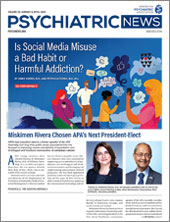What’s in a Label?
Abstract
Tracking prescribing for labeled and off-label conditions can be a useful tool for determining whether research on new indications and contraindicated indications is needed.
While psychotropic drugs are sometimes prescribed off label, a study published January 17 in Psychiatric Services in Advance demonstrates that FDA-approved labeling changes can significantly influence how providers select medications.

Peggy O’Brien, Ph.D., a researcher at Truven Healthy Analytics LLC, and colleagues used the National Disease and Therapeutic Index (NDTI) to examine three major categories of psychotropic medications—antidepressants, antipsychotics, and anxiolytics. The NDTI is a survey of more than 4,000 randomly selected, office-based physicians, which specifically asks physicians about the condition for which they prescribed a medication. The authors compared “snapshots” of data collected at two points—in 2005 and 2013.
The analyses showed that many significant changes in the use of a class of drugs for certain indications coincided with labeling changes: the addition of new indications for a class of drugs was associated with increased prescribing, while the addition of black-box warnings and associated side effects were associated with decreased use. For example, the use of antipsychotics for depressive disorders increased from 5.3 percent in 2005 to 13.6 percent in 2013, as numerous antipsychotics gained approval for treating depression. In contrast, prescriptions of antipsychotics for delirium, dementia, and related indications dropped from 7.4 percent in 2005 to 2.8 percent in 2013. The FDA first announced the boxed warning against this use in 2005.
The authors concluded that FDA-approved labeling “plays a major role” in physicians’ prescribing decisions, in part because pharmaceutical companies can promote labeled indications but not off-label uses.
Off-label prescribing is entirely legal, as it is the responsibility of the prescribing physician to make an informed medical judgment for individual patients. This judgment can be derived from scientific evidence beyond the approved product label. The authors pointed out that “labeled indications often lag the science.”
O’Brien and colleagues noted that one reason for the lag between research and new indications in labeling is certain disincentives in the current regulatory scheme. To add a new indication the company must first invest in clinical trials on the efficacy and safety for a new patient population and file a supplemental New Drug Application to the FDA. The potential return for gaining a new indication may not be sufficient to justify the cost.
“A number of factors may influence the decision to seek additional labeling for a medication, including whether it is already used off label and, particularly, if it is already [available in] generics,” O’Brien told Psychiatric News. “Each [supplemental] application and the research needed to support it can require considerable resources and expenditures.”
The current fee for filing a supplemental application with clinical data is over $1 million. Small companies can apply for waivers.
On the other hand, labeling approval may not be enough to convince physicians to prescribe a drug for the indicated use.
The proportion of prescriptions of antipsychotics to treat attention-deficit, conduct, and disruptive behavior disorders fell significantly—from 5.7 percent in 2005 to 3.0 percent in 2013—even though two antipsychotics, chlorpromazine and haloperidol, contain labeled indications for severe behavioral symptoms in children, including “short-term treatment of hyperactive children who show excessive motor activity with accompanying conduct disorders.” Haloperidol is approved for children as young as age three. (Second-generation antipsychotics are not labeled for these indications.)
The authors suggested that the decline was in response to published reports and increasing concerns about the pediatric use of antipsychotics for behavioral problems.
From 2005 to 2013, the use of anxiolytics to treat attention-deficit, conduct, and disruptive behavior disorders increased from 0.8 percent to 2.2 percent, and antidepressant use for these indications went up from 2.8 percent to 3.9 percent, although these uses were off label. Did prescribers substitute antipsychotics with anxiolytics and antidepressants to treat children with attention-deficit and conduct disorders? O’Brien acknowledged that it is possible but difficult to confirm from the data. “This possible substitution effect may merit further research,” she said.
“These findings highlight that labels are an important but imperfect guide for physicians to make prescribing decisions. This may be particularly true in psychiatry, given that the diagnostic schema that forms the basis for labels is highly imprecise,” the authors concluded. “Tracking prescribing for labeled and off-label conditions is a useful tool for illuminating whether new labeled indications may be appropriate, whether research on new indications and contraindicated indications is needed, and whether physicians may benefit from additional education about the application of particular medications for particular clinical scenarios.”
The study was funded by the Substance Abuse and Mental Health Services Administration. ■



